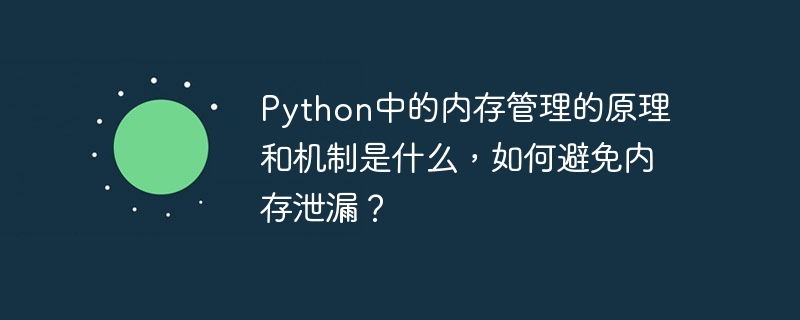

What are the principles and mechanisms of memory management in Python, and how to avoid memory leaks?
As a high-level language, Python provides a convenient programming environment through automatic memory management. Python's memory management mainly relies on the garbage collection mechanism to manage and release memory through reference counting and cyclic garbage collection.
In Python, each object has a reference counting counter. When an object is referenced, its reference count increases. When an object's reference count decreases to 0, it means that there are no references pointing to the object, and the object can be recycled by the garbage collection mechanism and the memory is released. This reference counting mechanism is simple and efficient, and can handle most memory management problems.
But reference counting cannot solve the problem of circular references. When two or more objects refer to each other, forming a circular reference, the reference counts of these objects will not be 0, leading to memory leaks. To solve this problem, Python also provides a cyclic garbage collection mechanism.
Circular garbage collection avoids memory leaks by detecting and handling circular references. When the garbage collection mechanism detects a circular reference, it marks all objects in the circular reference chain and decrements their reference count by one. Then, through a series of mark-clear operations, the objects in these circular reference chains are recycled and the memory is released.
In addition to the garbage collection mechanism, Python also provides some memory management tools to help us better control memory usage.
1. Avoid creating too many temporary objects:
Temporary objects refer to objects temporarily generated in the program, such as string splicing, list comprehension, etc. These objects usually take up a lot of memory, so you should try to avoid creating too many temporary objects. You can use the join() method to splice strings, use generator expressions to replace list comprehensions, etc. to reduce the generation of temporary objects.
# 字符串拼接 str_list = ['hello', 'world', 'python'] result = ''.join(str_list) # 列表推导 result = [x for x in range(100) if x % 2 == 0]
2. Manually release objects that are no longer used:
Although Python has a garbage collection mechanism to automatically release memory, for some objects that occupy a large amount of space, we can manually set their references to None to release memory promptly.
# 手动释放对象
def func():
big_list = [x for x in range(1000000)] # 占用大量内存的对象
process_big_list(big_list)
big_list = None # 手动释放内存3. Use generators instead of lists:
In Python, generators can generate results one by one instead of generating all results at once, thereby reducing memory usage. Whenever possible, generators should be used to handle large data sets. For example, use generator expressions instead of list comprehensions, use the yield keyword to define generator functions, etc.
# 生成器表达式
odd_nums = (x for x in range(1, 100) if x % 2 == 1)
# 生成器函数
def generate_nums():
for x in range(1, 100):
if x % 2 == 1:
yield xThrough the above methods, we can better understand the memory management principles and mechanisms in Python and avoid the occurrence of memory leaks. Proper use of memory management tools and techniques can improve the performance and stability of Python programs.
The above is the detailed content of What are the principles and mechanisms of memory management in Python, and how to avoid memory leaks?. For more information, please follow other related articles on the PHP Chinese website!
 How to unlock android permission restrictions
How to unlock android permission restrictions
 There are several output and input functions in C language
There are several output and input functions in C language
 Solutions to unknown software exception exceptions in computer applications
Solutions to unknown software exception exceptions in computer applications
 How to use spyder
How to use spyder
 Ripple trading platform
Ripple trading platform
 What are the benefits of java factory pattern
What are the benefits of java factory pattern
 memcpy function usage
memcpy function usage
 What software is premiere
What software is premiere




